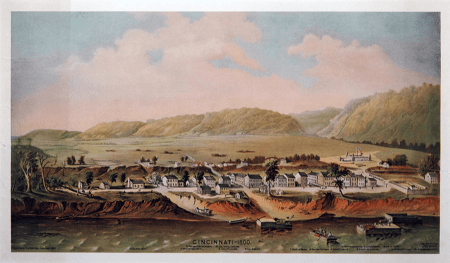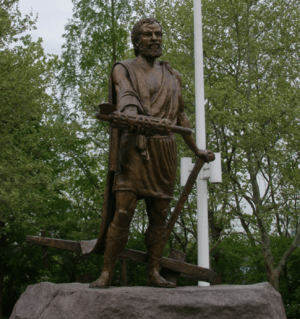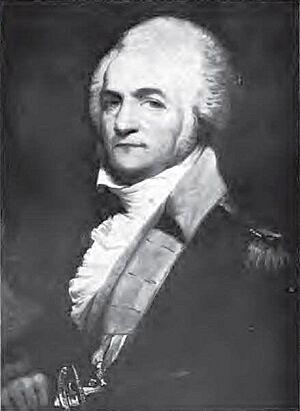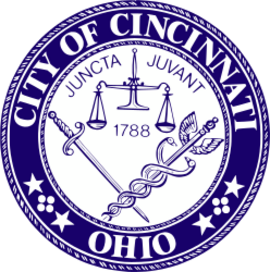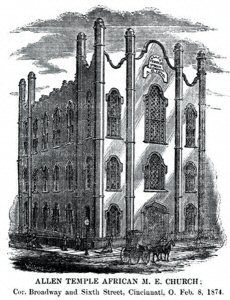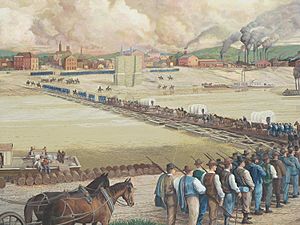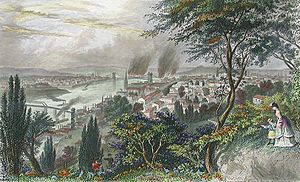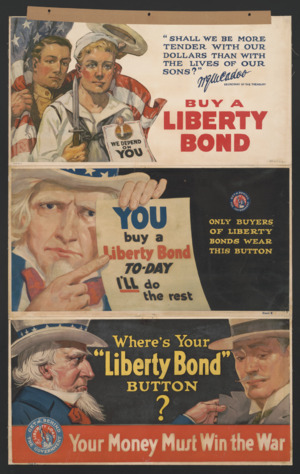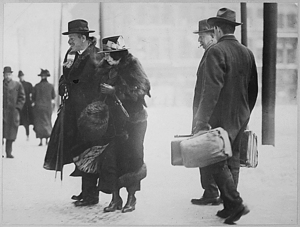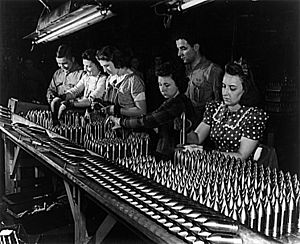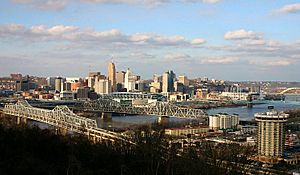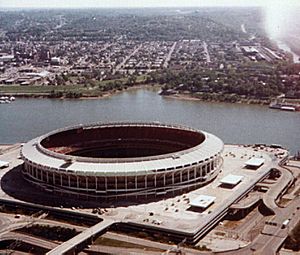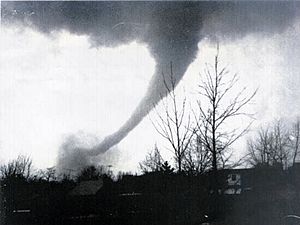History of Cincinnati facts for kids
Cincinnati started as three small settlements in the Northwest Territory of the United States in late December 1788. These were Columbia, Losantiville, and North Bend. The next year, Fort Washington was built to protect the settlers. It was named after George Washington.
Cincinnati became a town in 1802 and a city in 1819. It was first called "Queen of the West." The city grew quickly because it was located on the Ohio River. This made it a great place for pioneers traveling west to get supplies. Cincinnati had many warehouses, hotels, and restaurants to serve these travelers.
By 1850, Cincinnati was the sixth-largest city in the United States, with over 115,000 people. Before the Civil War, it was an important stop on the Underground Railroad. Thanks to the strong Defense of Cincinnati, no battles were fought in the city during the Civil War.
Over the years, Cincinnati has been known for many industries, like meatpacking, iron production, and building steamboats. During World War I and II, people in Cincinnati helped the war effort by joining the military, making supplies, and buying Liberty Bonds. These wars also created new opportunities for women and Black people. Today, Cincinnati is a major center for many companies and organizations.
Contents
Early History of Cincinnati
Native American Life
From about 900 to 1600 CE, a group called the Fort Ancient people lived in southwest Ohio. Many believe the Shawnee people are their descendants. These groups were hunter-gatherers. They lived in villages during the summer and hunted animals in the winter across the Ohio River Valley. Men hunted and protected their tribes, while women gathered food and farmed. They built wigwams for homes in their villages.

Life for Native Americans began to change in the mid-1600s. European settlers started moving onto their lands. This led to competition for hunting grounds and the fur trade. Many Shawnee and other tribes were forced out of Ohio by the Iroquois Confederacy in the 1640s. They returned around 1701 after a peace treaty. However, land disputes with the colonies continued.
The Shawnee supported the French during the French and Indian War (1754–1763). More land disputes and treaties followed. After major battles in 1792 and 1794, eleven tribes signed the Treaty of Greenville in 1794. This treaty forced them to give up most of their land.
The Symmes Purchase
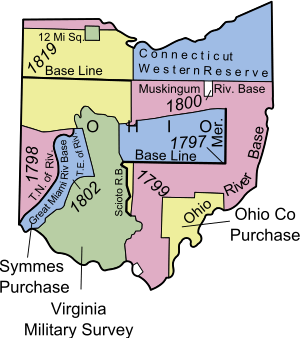
After the Revolutionary War, the United States began to expand west. New lands opened up north of the Ohio River in the Northwest Territory. In 1786, Benjamin Stites explored the Little Miami Valley and found fertile land. This news reached John Cleves Symmes, a delegate in the Continental Congress. In 1787, Symmes bought a large area of land, about one to two million acres, from the government. This area was called the Symmes Purchase or the Miami Purchase. It was located between the Great and Little Miami Rivers and later became Warren, Butler, and Hamilton Counties.
First Settlements
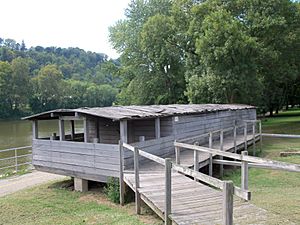
Pioneers traveled on flatboats along the Ohio River to settle the area that would become Cincinnati. The city started as three separate settlements: Columbia, Losantiville, and North Bend.
Columbia was settled first on November 18, 1788, by 26 people led by Benjamin Stites. They built a blockhouse and log cabins. The settlers worked hard to find enough food by fishing, hunting, and farming. Columbia grew quickly at first and became an important trading center. The first Protestant church in the Northwest Territory was built there.
Losantiville
On December 28, 1788, eleven families arrived across from the Licking River. This settlement was named Losantiville by its first surveyor, John Filson. The name means "The city opposite the mouth of the river." The group was led by Colonel Robert Patterson. Israel Ludlow later became the surveyor and designed the town with a grid plan.
Losantiville grew quickly. By 1790, it had 700 people, including many new settlers and soldiers from Fort Washington. Symmes described Losantiville as a town with forty two-story log houses, looking "of some respectability."
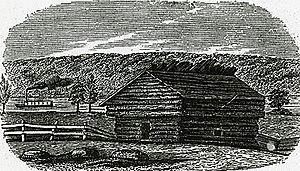
North Bend was founded by Symmes in February 1789, a few miles west of Losantiville. Settlers there also faced challenges finding enough food at first.
Fort Washington
Leaders like Symmes were worried about Native American tribes resisting the new settlements. The vast Northwest Territory was protected by only 300 soldiers. Native American tribes were unhappy about white settlers moving onto their lands, leading to conflicts. Most Native American tribes in the Northwest Territory were allied with the British.
In 1789, Fort Washington was built under General Josiah Harmar. It was named after President George Washington. This fort protected the entire Northwest Territory for five years. After the Treaty of Greenville was signed in 1795, the fort was no longer needed and was torn down in 1808.
How Cincinnati Got Its Name
On January 4, 1790, Arthur St. Clair, the governor of the Northwest Territory, changed the settlement's name to "Cincinnati." He did this to honor the Society of the Cincinnati, a group of Revolutionary War officers he led. The society was named after Cincinnatus, a Roman general who saved Rome and then returned quietly to his farm.
Early Life in Cincinnati
Early settlers often used rabbit and deer pelts to trade for goods. Many Revolutionary War soldiers received land in the area as payment for their service. Other civilians also came, hoping to find new opportunities by buying affordable land.
Hamilton County was created on January 4, 1790. As tensions grew between settlers and Native Americans, rules were made to prevent reckless shooting and selling alcohol to Native Americans. All men were expected to serve in the military to defend their settlements. Some people even moved to safer communities in Kentucky in 1790.
By 1795, the population grew, and many businesses opened, including furniture makers, butchers, and bakers. There were also 30 warehouses to supply pioneers and soldiers traveling west on the Ohio River.
Cincinnati became a chartered town on January 1, 1802. By 1803, it had about 1,000 residents. The city continued to grow, reaching nearly 10,000 residents by 1820. The arrival of steamboats on the Ohio River in 1811 greatly helped the city's growth.
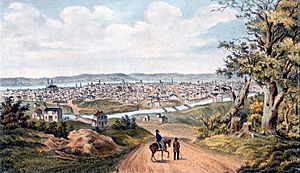
In the early 1800s, Cincinnati offered many services for travelers, such as restaurants, taverns, and hotels. The Ohio River was key for transportation. Crops were shipped to markets like New Orleans via the Ohio and Mississippi Rivers. The Miami and Erie Canal also helped reduce shipping costs for goods from western Ohio. Cincinnati became a major center for repairing and building steamboats. It also became a huge meatpacking center, earning it the nickname "Porkopolis" because so much pork was processed there.
Becoming a City and Before the Civil War
Cincinnati officially became a city on March 1, 1819. That same year, the city started publishing directories that listed residents' names, jobs, and addresses. These old directories are still useful for learning about early residents. The Medical College of Ohio was also founded in 1819.
By 1850, Cincinnati was the sixth-largest city in the country. It was also the first U.S. city to open a Jewish Hospital in 1850.
Police and Fire Services
When Cincinnati became a city in 1819, its first city marshal, William Ruffin, was appointed. By 1828, the police force had one captain, one assistant, and five patrolmen. In 1853, Cincinnati created the first full-time paid fire department in the United States. It was also the first in the world to use steam fire engines.
Abolitionists and the Underground Railroad
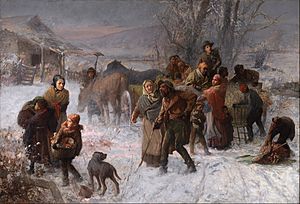
Cincinnati was a very important stop on the Underground Railroad before the Civil War. It was located right across the Ohio River from Kentucky, a state where slavery was allowed. Many people escaping slavery came through Cincinnati.
Allen Temple African Methodist Episcopal Church was founded in 1824. It was Ohio's first Black church and a key stop on the Underground Railroad for many years.
Lane Theological Seminary was established in Cincinnati in 1829 to train ministers. Famous pastor Lyman Beecher moved his family, including his daughter Harriet, to Cincinnati in 1832 to lead the Seminary.
Lane Seminary is famous for its "debates" in 1834, which greatly influenced national discussions about slavery. Many people involved in these debates later became important leaders in the abolitionist movement.
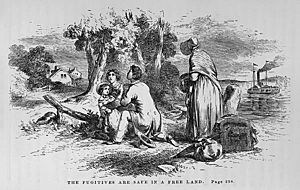
Abolitionist writer Harriet Beecher Stowe lived in Cincinnati. She wrote Uncle Tom's Cabin, which was first published in 1852. This book became the best-selling novel of the 19th century and helped to strengthen the anti-slavery cause in the United States before the Civil War. Over 300,000 copies were sold in its first year. You can visit The Harriet Beecher Stowe House in Cincinnati.
The National Underground Railroad Freedom Center is located in downtown Cincinnati by the Ohio River. It teaches about the history of slavery and promotes freedom around the world. It opened in 2002 with a big celebration.
Race Relations Before the Civil War

Because Cincinnati was across the river from Kentucky, a slave state, it was a natural stopping point for people escaping slavery. Anti-slavery writings and newspapers were published in Cincinnati and sent to the South.
However, some people in Cincinnati worried that Black people would take their jobs. This led to tensions. For example, in 1829, Irish immigrants believed Black people were taking their job opportunities. This led to the Cincinnati Riots of 1829 in July and August, where white residents attacked Black people. Many Black residents, about 1,200, left the city and moved to Canada as a result.
As the anti-slavery movement grew, more riots occurred. In 1836, whites attacked a printing press that published an anti-slavery newspaper. The mob also attacked Black neighborhoods. Another riot happened in 1841.
Cincinnati's Nicknames
Cincinnati was first called "Queen of the West" in 1819. This name was used in a local newspaper, praising the city for its order, spirit, and generosity. Soon, people began calling it "The Queen City."
Henry Wadsworth Longfellow also wrote about Cincinnati as "The Queen of the West" in his 1854 poem Catawba Wine.
The nickname "Porkopolis" started around 1840. Cincinnati became known as the country's main pork-processing center. By 1840, over $3 million worth of packed pork was produced by 1,200 men in 48 packing houses. However, by 1875, Chicago became the new meatpacking center and took over the "Porkopolis" nickname.
Cincinnati is also known as the "City of Seven Hills." These hills form a crescent shape around the city: Mount Adams, Walnut Hills, Mount Auburn, Vine Street Hill, College Hill, Fairmount, and Mount Harrison.
Cincinnati During the Civil War
During the American Civil War, some people in the Cincinnati area supported the Southern states. This was because Cincinnati had strong business ties with slave states. However, most people from the area joined the Union Army.
Cincinnati was very important to the Union Army. It provided many supplies and troops. It also housed soldiers and their families, which helped the city's economy. Cincinnati served as the main headquarters for the Department of the Ohio, which defended the region and directed army movements.
In July 1863, the Union Army declared martial law in Cincinnati because of the threat from Confederate Morgan's Raiders. These raiders attacked nearby villages.
During the Civil War, Cincinnatians built an eight-mile defense line along the Ohio River to protect the city. Thanks to the efforts of the Black Brigade of Cincinnati and the overall Defense of Cincinnati, the city did not need to fire a single shot during the Civil War.
After the Civil War: Late 1800s
By the late 1800s, Cincinnati was Ohio's largest city, with nearly 300,000 people. It was also one of the most crowded cities in the country.
The city had many cultural attractions, including an art academy, an art museum, Music Hall, an opera house, and a public library. There were also many magazines and newspapers, over 200 churches, five hospitals, and the University of Cincinnati. In 1888, a "sick house" (Krankenhaus) was started by German Protestants, which became the city's first general hospital.
Sports in the 1800s
The Cincinnati Red Stockings, a baseball team that inspired today's Cincinnati Reds, started in the 19th century. In 1869, they became the first professional baseball team in the country. In their first year, they won 57 games and tied one, setting a record for the best winning record.
Business Growth
In 1879, Procter & Gamble, a major soap maker in Cincinnati, began selling Ivory Soap. It was famous for being "light enough to float." After a factory fire, Procter & Gamble moved to a new factory called Ivorydale. Cincinnati was also the first city to own a railroad, the Cincinnati Southern, in 1880.
By 1887, industries in Cincinnati produced over $200 million in goods and employed more than 103,000 people. By 1890, it was an important industrial, political, and educational center. Its main industries were iron production, woodworking, cloth production, and meatpacking. Cincinnati also became known for making inexpensive carriages, which many people could afford.
20th and 21st Century Cincinnati
Cincinnati's population didn't grow much in the 20th century. In the 1880s, it had 300,000 people, and by 2000, it had 365,000 people within the city limits. However, over 1.8 million people now live in Cincinnati's surrounding suburbs.
The greater Cincinnati area has over 100 art galleries, including the Contemporary Arts Center, Cincinnati Art Museum, and Taft Museum of Art. The city's theaters include the Aronoff Center for the Arts and the Playhouse in the Park. Cincinnati is also home to the Cincinnati Zoo and Botanical Garden.
World War I
During World War I (1914–1918), 25,000 men from Cincinnati served in the military. Citizens and children supported the war in many ways. They "adopted" French children, collected tin foil, planted "war gardens," and made clothing for soldiers. Local factories changed their production to make war supplies like munitions, camping gear, and battleship parts. Millions of dollars were raised for Liberty Loans and relief funds. Women and African-Americans took on jobs that men had previously held.
During the war, there was strong anti-German feeling. The conductor of the Cincinnati Symphony Orchestra, Ernst Kunwald, was even held as a prisoner of war. The city's library removed pro-German books, and public schools stopped teaching German.
World War II
After World War I, many people didn't want to get involved in another war. But after the attack on Pearl Harbor on December 7, 1941, the United States entered World War II (1939–1945).
Almost 100,000 men and women from the Cincinnati area served in the war. Women took on support roles like radio operators. African-Americans served in separate units. The war created new opportunities for both Black people and women in the military and in factories.
In Cincinnati, 2,000 manufacturers with over 180,000 employees worked to produce goods for the military. Factories made engines for planes, food, soap, clothing, and even changed from making women's clothing to parachutes. Cincinnati's location with railroads, river barges, and airports helped transport raw materials and goods.
Like in World War I, Cincinnatians strongly supported the war. They planted victory gardens, organized bond drives, and collected materials like rubber and scrap metal. There were also rationing efforts for scarce goods like butter, meat, and gasoline to ensure supplies for the military.
Modern City Development
In 1902, the world's first reinforced concrete skyscraper, the Ingalls Building, was built in Cincinnati. Construction for the Cincinnati Subway began in 1920. After World War II, Cincinnati started a major plan to modernize its inner city. Since the 1950s, hundreds of millions of dollars have been spent on improving neighborhoods and creating jobs.
The city and county developed The Banks, a new urban neighborhood along the riverfront with restaurants, clubs, offices, and homes. Groundbreaking for this project happened in 2008. Next to it is Smale Riverfront Park, a beautiful public space.
A 3.6-mile streetcar line, called the Cincinnati Bell Connector, was completed in 2015. It runs through downtown and Over the Rhine.
Modern Businesses
Many large companies have their regional or national headquarters in Cincinnati. These include American Financial Group, Kroger, Procter & Gamble, E. W. Scripps Company, and Totes Isotoner.
Sports in Modern Cincinnati
In 1935, the first major league baseball night game was played at Crosley Field in Cincinnati.
In the 1970s, the city built Riverfront Stadium and Riverfront Coliseum. The Cincinnati Reds baseball team, known as the "Big Red Machine," became one of the best teams in baseball history in 1975 and 1976. Key players like Johnny Bench, Tony Pérez, and Joe Morgan, and manager Sparky Anderson, are in the Baseball Hall of Fame. Pete Rose holds many baseball records.
The Cincinnati Bengals football team was founded in 1968 by coach Paul Brown. The team has played in three Super Bowls.
FC Cincinnati, the city's professional soccer team, started in 2015. It gained international attention for its large crowds. The team joined Major League Soccer in 2019.
Boy Scouts
"The Sons of Daniel Boone", an early group that led to the Boy Scouts of America, began in Cincinnati in 1905.
Media and Innovation
In 1939, Cincinnati's AM radio station, WLW, was the first to broadcast at 500,000 watts. In 1943, King Records was founded and recorded early music by famous Country, R&B, and Rock artists. WCET-TV became the first licensed public television station in 1954. Cincinnati is also home to WEBN 102.7 FM, the longest-running album-oriented rock station in the U.S., starting in 1967. In 1976, the Cincinnati Stock Exchange became the nation's first all-electronic trading market.
Race Relations
Cincinnati has experienced several incidents of race-based tension throughout its history, with the most recent notable one being the 2001 Cincinnati Riots.
Disasters
Cincinnati has faced several floods, with the largest being the Ohio River flood of 1937. The river reached 80 feet deep, which was 55 feet above its normal level.
On December 3, 1979, 11 people died in a crowd crush at the entrance of Riverfront Coliseum before a rock concert by the band The Who.
Being in the Midwest, Cincinnati has also experienced strong tornadoes. During the 1974 Super Outbreak, an F5 tornado crossed the Ohio River into Cincinnati. It caused damage in Sayler Park and other suburbs. Another strong F4 tornado hit the area in 1999, killing four residents.
See also
 In Spanish: Historia de Cincinnati para niños
In Spanish: Historia de Cincinnati para niños


